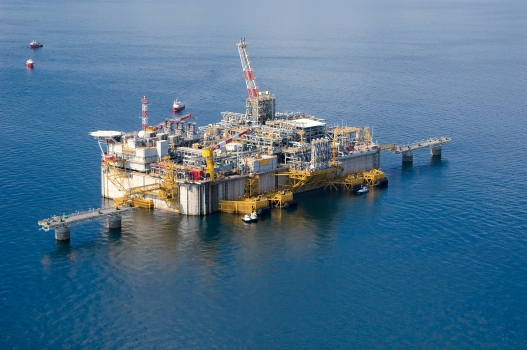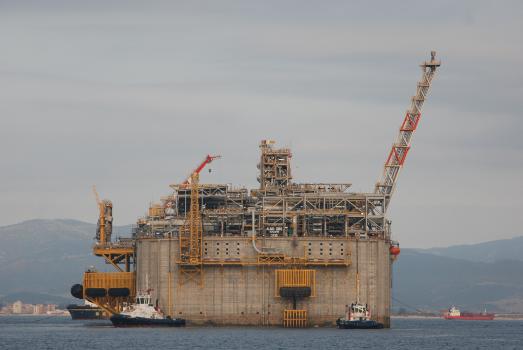General Information
Project Type
| Structure: |
Concrete gravity base structure |
|---|---|
| Function / usage: |
Liquefied natural gas reservoir |
Location
| Location: |
Adriatic Sea, Italy |
|---|---|
| Coordinates: | 45° 5' 30" N 12° 35' 10" E |
Technical Information
Dimensions
| total weight | 280 929 t | |
| total height | 80 m | |
| gravity base | ||
|---|---|---|
| width | 88 m | |
| height | 47 m | |
| length | 180 m | |
| weight | 241 544 t | |
| topside | ||
| weight | 18 315 t | |
Quantities
| gravity base | ||
|---|---|---|
| concrete volume | 90 000 m³ | |
| prestressing steel | 2 x 2 050 t | |
| reinforcing steel | 27 000 t | |
| formwork | 215 000 m² | |
| number of anchors | 3 900 | |
Materials
| gravity base |
prestressed concrete
|
|---|
Case Studies and Applied Products

HRC 100 & 200 Series T-headed reinforcement
T-headed rebar is common reinforcing steel with a small steel plate attached to one or both ends of the bar. The T-head works as anchoring device as an alternative to hooks or bends. The generic term for T-heads is "mechanical anchoring ... [more]

HRC 400 series reinforcement couplers
High performance reinforcement couplers with proven and documented quality. Exceed all known requirements for reinforcement couplers.
[more]Excerpt from Wikipedia
The Adriatic LNG terminal is a liquid natural gas offshore terminal, formally known as Terminale GNL Adriatico Srl. Located in the northern Adriatic 9 miles (14 km) offshore of Porto Levante, Porto Viro, near Rovigo, Italy, it is the world's first offshore gravity-based structure LNG regasification terminal. The terminal is operated by ExxonMobil (70%), Qatar Terminal Ltd., a subsidiary of Qatar Petroleum (23%), and Snam (7%).
Construction
The terminal facility was built in Campamento, parish of San Roque, Spain, then towed to Porto Levante, Italy. Construction started in October 2003 and finished in August 2008. The LNG tanks were constructed in South Korea. The pipeline that connects to the terminal is located south of the Levante Po River mouth near Scanno Cavallari.
Moving
After construction was completed in Campamento, the rig was towed by four tugboats to its current location off the coast of Rovigo. The flotilla traveled the 1,700 nautical miles (3,100 km; 2,000 mi) in 16 days to reach the site. It traveled at an average speed of 4.4 knots (8.1 km/h; 5.1 mph). When it arrived, the terminal was weighted down by water to ensure it was permanently positioned on the seabed.
Operations
Operations started in the mid of 2009. It received its first cargo on 11 August 2009. When fully operational, it stores and regasifies 8 billion cubic metres (280 billion cubic feet) of natural gas per year, enough to meet 10% of Italy's natural gas needs. The terminal receives a LNG carrier every three days from Qatar. The gas is then regasified and sent to the Italian gas network by a pipeline from the terminal to the coast.
Text imported from Wikipedia article "Adriatic LNG terminal" and modified on July 23, 2019 according to the CC-BY-SA 4.0 International license.
Participants
- Aker Solutions ASA
- IBERINSA (concrete)
- Skanska Norge AS
Relevant Web Sites
Relevant Publications
- (2010): Concrete gravity-based structures used for offshore LNG storage and regasification in the Adriatic Sea. In: Structural Concrete, v. 11, n. 2 (June 2010), pp. 73-81.
- (2008): Obra Cajón Adriatic LNG Terminal Algeciras. In: Hormigón y acero, v. 59, n. 247 (1st Quarter 2008), pp. 11-40.
- (2008): Trabajos de postesado en la construcción de la planta de almacenamiento y regasificación "Adriatic LNG Terminal". Presented at: IV Congreso de la Asociación Científico-Tecnica del Hormigón Estructural - Congreso Internacional de Estructuras, Valencia, 24-27.11.2008.
- About this
data sheet - Structure-ID
20049433 - Published on:
04/12/2009 - Last updated on:
22/11/2018







